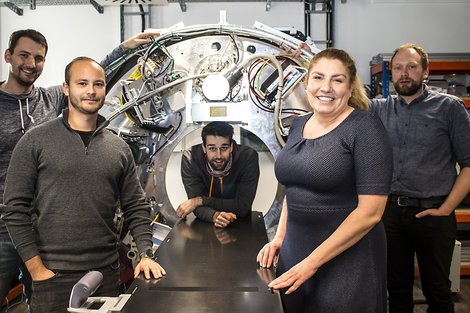The CT scanner becomes the operating room
Magdeburg start-up RAYDIAX develops the world’s first computer tomographs (CTs) for cancer treatment
“Globally, there are no computer tomographs that have been specially developed for minimally invasive cancer therapy,” states Thomas Hoffman, one of RAYDIAX’s co-founders, who is looking forward to 2026 when his start-up team is aiming to bring just such a product to the market. The new therapy-assisting CT scanner will be used primarily to offer patient-friendly treatment of liver and lung tumors. RAYDIAX is the name of the six founders who have developed this CT system on the Research Campus STIMULATE based in the Magdeburg Science Port.
RAYDIAX is about to launch its business, as the name is already well on its way to becoming a respected brand. Because of its innovative concepts, the project receives millions of euros in funding from the German government’s EXIST Research Transfer Program. “For costly start-ups like ours, this funding is highly sought after, and we consider this approval to be a real accolade,” says Hoffman. The name RAYDIAX is a play on words from “X-ray” and “Radiation”: compared to previous CT systems, radiation levels will be about 40 per cent lower in the new device – crucial for use as an “operating room”. “The requirements for protecting the health of, and minimizing the risks to, attending clinical staff must be fulfilled. Ultimately, the surgeons are close to the patient in the CT system for the entire treatment time and their exposure to radiation should not be underestimated,” explains Hoffman. The 35-year-old from Magdeburg had studied mechanical engineering at the Otto von Guericke University in his home town but his interest led him to medical technology. He wrote his doctoral thesis on the KIDs-CT Project at the Research Campus STIMULATE. “Konfigurierbarer, Interfaceoffener, Dosissparender Computertomograf”, or KIDs-CT for short, meaning a configurable, open-interface and dosage-sparing computer tomograph which can be used with interchangeable hardware and software modules, offering flexibility and quick adaptation to different application scenarios.
A reduced dose of radiation
For a long time now, computer tomography has not just provided images to support professional diagnoses. For example, CT-controlled therapy enables catheters or needles to be precisely positioned in the body and reduces the risk of complications compared to conventional “open” surgery. In the meantime, minimally invasive procedures will also be performed in the CT scanner. “Admittedly, under difficult conditions. Computer tomographs are not designed for use in the operating room,” says Hoffman. But it is well known that problems drive innovation. “Using our work at KIDs-CT as a basis, we want to develop a completely new therapy-assisting CT scanner for minimally invasive cancer treatment. In addition to reducing the dose of radiation, the new development will also include special features to support surgical procedures – such as the integration of rapid imaging techniques and a navigation system which the operator can use to precisely locate the tumor. We are also expanding the diameter of the scanner so that the attending physicians can have better patient access,” says Hoffman. By “we”, he means his partners Dr Tim Pfeiffer and Robert Frysch from the field of X-ray physics, X-ray hardware developers Dr André Mewes and Benjamin Fritsch and, last but not least, business development manager Galina Steinke.
Operating efficiently and saving costs
The young founders are advised by a clinical and technical advisory board comprising national and international experts – who have a good reputation in the search for investors to co-finance the development of the device.
Hoffman says that there are already very positive signals from the field about the need for the RAYDIAX device because, when compared to the Da Vinci surgical robot, for example, minimally invasive CT-guided operations can be performed using even smaller instruments and without a general anaesthetic. Extremely fine needles heat the tumor tissue in a precisely defined manner to between 60 and 90 degrees, which is destructive. The procedure shows optimal results in the treatment of tumors up to two centimeters in size. In palliative medicine, according to Hoffman, tumors can be shrunk using the technique, and pain reduced.
RAYDIAX’s principal clinical partner is the University Clinic for Radiology and Nuclear Medicine at the University Hospital in Magdeburg. The founders have other research-savvy university hospitals in their sights as potential customers for the high-tech device. Hoffman thinks that the device will also attract the interest of public and private hospitals, because it will allow them to operate more efficiently, save costs and compensate for the shortage of specialist skills.
A unique research infrastructure
The RAYDIAX team has a detailed schedule. The first step, according to this schedule, is to set up the company – and it has to be in Saxony-Anhalt. Thomas Hoffman calls the research infrastructure here “unique”. In 2020, STIMULATE was awarded “Center of Excellence Saxony-Anhalt” status. The cooperative alliance, formed in 2013 between the Otto von Guericke University Magdeburg, Siemens Healthcare GmbH, the STIMULATE association and many other stakeholders in the healthcare sector, carries out research into medical technology solutions for treating what are referred to as widespread diseases such as strokes, heart attacks and cancer.
This “Center of Excellence” has gained an international reputation as a “research and innovation center for image-supported medicine”. RAYDIAX wants to be a core company at the heart of this center. “We want to create attractive working and living conditions here, so that many more young professionals and start-ups will choose our science port as an innovation hub,” says Hoffman.
Author: Kathrain Graubaum/IMG Saxony-Anhalt

